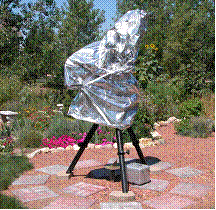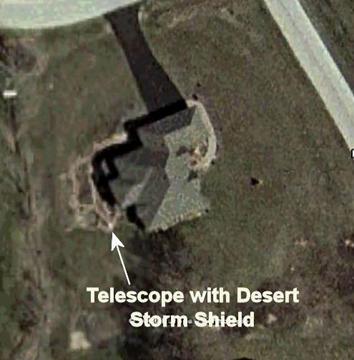A Temporary Scope Shelter
Jack Kramer
When you go to a dark site for an observing run that extends for several days, you'll want to leave your telescope set up for the duration... but protected from the elements. For many years, I used to buy equipment covers from my local hardware store. These amounted to huge yellow plastic bags that were more than large enough to cover any telescope. Wrapped with a bungee cord at the base, it effectively kept rain or dew off a scope. But after a number of uses, especially in windy conditions, the covers got pretty torn up.
Something more substantial was needed, especially since I had begun leaving a telescope set up on a pad in my back yard for days, or even weeks, at a time. A couple of LCAS folks had used "Desert Storm Shields", which are heavy duty Mylar covers that not only protect the scope from moisture, but by virtue of its shiny surface, also diminishes the effects of heat from the sun. These covers come in a variety of sizes to fit different telescopes. I ordered one from High Point Scientific, simply telling them what telescope I have and they told me what size was needed. Mine is sized to cover a 6-inch refractor on a German equatorial mount, and cost about $40. I've since noticed that High Point now only lists DSS covers for smaller telescopes. However, durable covers specifically for larger scopes are available from other suppliers, including Cases and Covers and Astronomics.

As shown in this photo, the DSS covers the telescope and equatorial head, leaving only the lower part of the legs exposed. This type of scope configuration presents a rather awkward shape, but the DSS can more neatly slip over a Dobsonian tube stowed in the vertical position as well as its rocker box. I've also used it to cover my 12-inch Dobsonian. An elastic strap was included for use in securing the DSS in place over the telescope.
I was told by the rep at High Point Scientific to be careful that the cover isn't pulled too tightly over any sharp protrusions on the scope or mount because this might cause it to rip if the weather turns windy. I haven't taken any special precautions, and despite three years of exposure to some very windy conditions both at home and at darker sites, the DSS remains perfectly intact.
A telescope shrouded with a shiny cover invites some interesting reactions. It's a signal to the neighbors that I might be observing on a clear night and some have stopped over in the evening to take a look through the telescope. One morning after the refractor was left out on a snowy night, a neighbor's five-year-old son excitedly told his mother, "Look, Mr. Kramer has a space snowman in his back yard!" And when NASA scanned our area for the image used in Google Earth, it was obviously at a time when I had a telescope set up with the cover in place. In the following picture of my house, the scope shows up as a bright spot exactly where my telescope pad is located. Yes, the telescope (with the DSS cover) is visible from space!

I'm thinking of someday building a roll-off roof observatory shed, but the problem is that my refractor and Dobsonian would each require a slightly different configuration of the walls and floor. One of my neighbors has a large observatory with a split roof to house his two telescopes, but I prefer something less elaborate. My thought is to design an observatory in which either telescope could be set up. In the meantime, the DSS cover has nicely answered the need to protect whatever scope I happen to be using at the time.
Published in the December 2006 issue of the NightTimes




